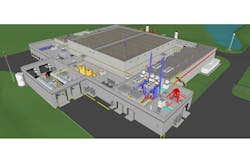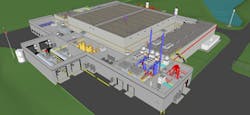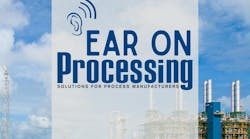By Tom C. Bachman
High-strength wastes — characterized by elevated levels of organics in wastewater as measured by biological oxygen demand, total suspended solids and oil & grease — are increasingly difficult and costly to manage.
Soil conditions, odor ordinances and other constraints limit the availability of land-application waste sites. Trucking or otherwise transporting high-strength waste to distant sites takes time and money. But if no suitable application sites are within reasonable proximity of the waste source, transporting may be the only option.
Additional circumstances make land-application programs for managing high-strength waste challenging and costly. In general, with increasingly stringent regulations protecting soil and water quality, land application is less sustainable than ever.
It’s not entirely surprising then, that as companies strive for efficiency and sustainable business practices, waste-to-energy projects are more viable. Energy generated from high-strength waste is "clean," and it reduces waste management cost and liability. Modern waste-to-energy technology is proved safe, environmentally friendly and economical.
Many projects are underway throughout the United States to convert waste into electricity.
Typical projects use anaerobic bacteria to break down organic matter in the waste stream to produce biogas — principally methane — which is subsequently burned to generate electrical power. It’s done at landfills and at manufacturing sites producing a continuous flow of high-strength organic wastes.
Green energy-funding incentives in pursuit of sustainable practices are an opportunity for "regional" project development, i.e., projects that secure wastes from multiple sources to amass a volume sufficient to economically justify anaerobically treating the wastes to generate electrical power.
Real-life waste-to-energy projects
Symbiont is involved in a number of such projects, including several in Wisconsin.
Green Whey Energy, Inc., located in Turtle Lake, Wis., collects over 300,000 gallons per day (gpd) of high-strength wastes from six food-processing facilities. A pair of 2-million-gallon capacity high-rate anaerobic digesters biologically will treat the waste stream to produce about 1,000 cubic feet per minute (cfm) of biogas.
The biogas will then be filtered, dehumidified and compressed to meet the fuel specifications of the engine generator. The treated biogas will be burned in two internal combustion engines to generate 3.2 MW of green energy. Heat captured from the engines will be transferred to an adjacent food processing facility, reducing its need for natural gas. Effluent from the digester will be further treated with a moving bed aerobic bioreactor and via dissolved air floatation prior to discharge to the city sewer.
At FCPC Renewable Generation, LLC, owned by the Forest County Potawatomi Community (FCPC) and located in Milwaukee, Wis., a project is being implemented that will collect 120,000 gpd of high-strength wastes from multiple food processing facilities around Milwaukee. Wastes will be trucked to a regional waste-to-energy facility in the Menomonee River Valley, immediately west of downtown Milwaukee. A pair of 1-million-gallon high-rate anaerobic digesters will biologically treat the organics to generate about 700 cfm of biogas. Biogas will be treated and used in two internal combustion engines to generate 2.0 MW of green energy. The project supports FCPC initiatives for creation of renewable energy.
Last but not least, Grande Cheese Co. saw it could reduce cost and liability associated with land application of high-strength wastes generated at its Brownsville, Wis., facility by implementing a waste-to-energy project. It involved a two-stage digestion process that maximizes loading rates while protecting the specific anaerobic bacteria colonies. Acid-forming bacteria (for waste breakdown) are isolated from the methanogenenic bacteria (for biogas generation) in two separate reactors that operate under different conditions. Biogas generated by the anaerobic process will be burned in microturbines. Effluent from the anaerobic digester will be treated in Grande’s existing aerobic treatment system prior to being discharged to a local receiving stream.
Primary and secondary objectives
The primary project objective was use of biogas as a fuel source to produce electricity for Grande’s cheese and whey plants. After drying and compressing, the biogas will be fired in two 200kW microturbines. The electricity produced by the microturbines will displace electricity being purchased from the utility.
The system treats over 60,000 gpd of high-strength wastewater that would otherwise have to be trucked to a municipality or land applied. The trucking cost, fuel savings, reduced emissions and reduced land management effort are significant. Savings are over $1.5 million per year.
The anaerobic treatment system is currently producing approximately 120,000 standard cubic feet of biogas daily, averaging more than 68% methane with less than 700 ppm hydrogen sulfide and no siloxanes. The energy value of the biogas is about 82 million BTUs per day (MMBTU/day).
The addition of the anaerobic digestion process allowed the facility to treat less BOD in the existing aerobic treatment system (some waste streams have been redirected from the aerobic system to the more efficient anaerobic process). As a result, less sludge is generated by the aerobic system. The facility benefits from lower costs for chemical addition and waste-activated sludge disposal. The potential of the treatment process to achieve biological phosphorus removal could result in additional savings as the quantity of phosphorus precipitating chemicals will be reduced by 50%.
Final thoughts
With the emphasis on renewable energy several available funding mechanisms can help projects move from concept to realization. On the Federal level, the Investment Tax Credit and the New Markets Tax Credit are potential mechanisms to help make projects economically attractive. Many states have similar incentive programs available to stimulate these types of projects. Utilities, most with goals for increasing power from renewable energy sources, are normally interested in evaluating and potentially purchasing power from these projects. Finally, private investors that participate in the energy sector are also potential sources of funding.
The economic and environmental benefits of waste-to-energy projects have been demonstrated. Anaerobic treatment technologies are cost-effective means of managing high-strength organic wastes and avoiding expensive land-application programs or high treatment costs imposed by municipal wastewater treatment plants.
Thomas C. Bachman, P.E. is a vice president at Symbiont Science, Engineering and Construction. As a senior project manager at Symbiont, Bachman has been involved in water and wastewater projects for both municipal and industrial clients since 1988. He holds two Master Degrees; one in Business Administration and another in Environmental Engineering, both from Marquette University. He can be reached at [email protected]
Symbiont is a provider of science, engineering, and technical consulting services and design-build services for public and private sector clients. The company, headquartered in Milwaukee, Wis., executes unique wastewater treatment projects nationally for industries. Symbiont provides complete in-house engineering services and specializes in renewable energy projects, with a market focus on green energy and sustainable practices. Symbiont provides engineering and design-build construction of anaerobic digesters to produce biogas for a variety of use methods.



